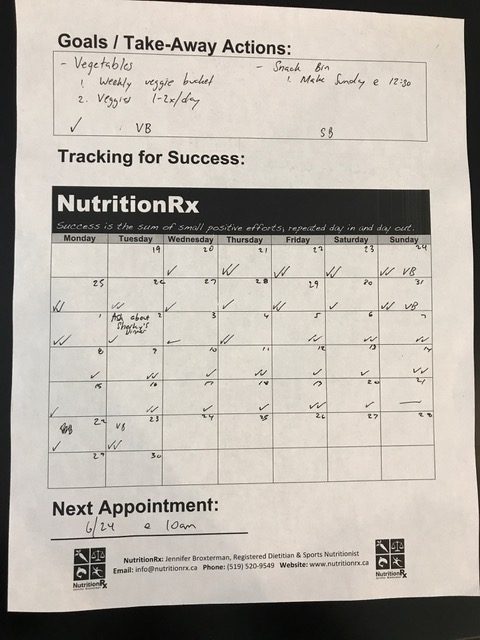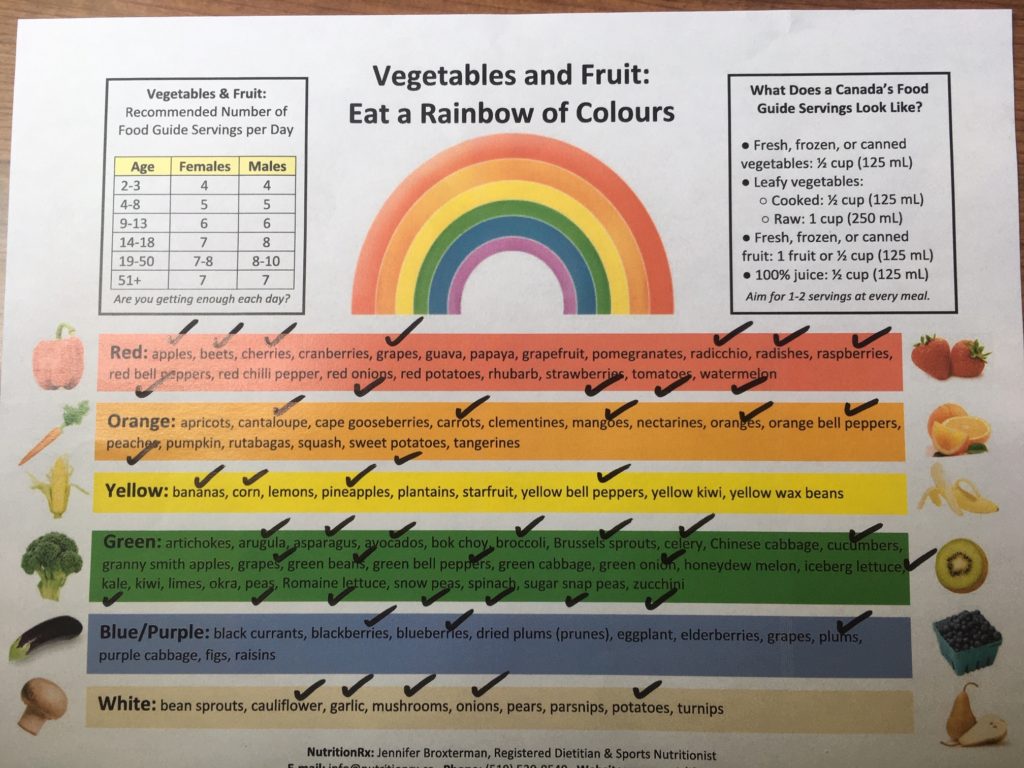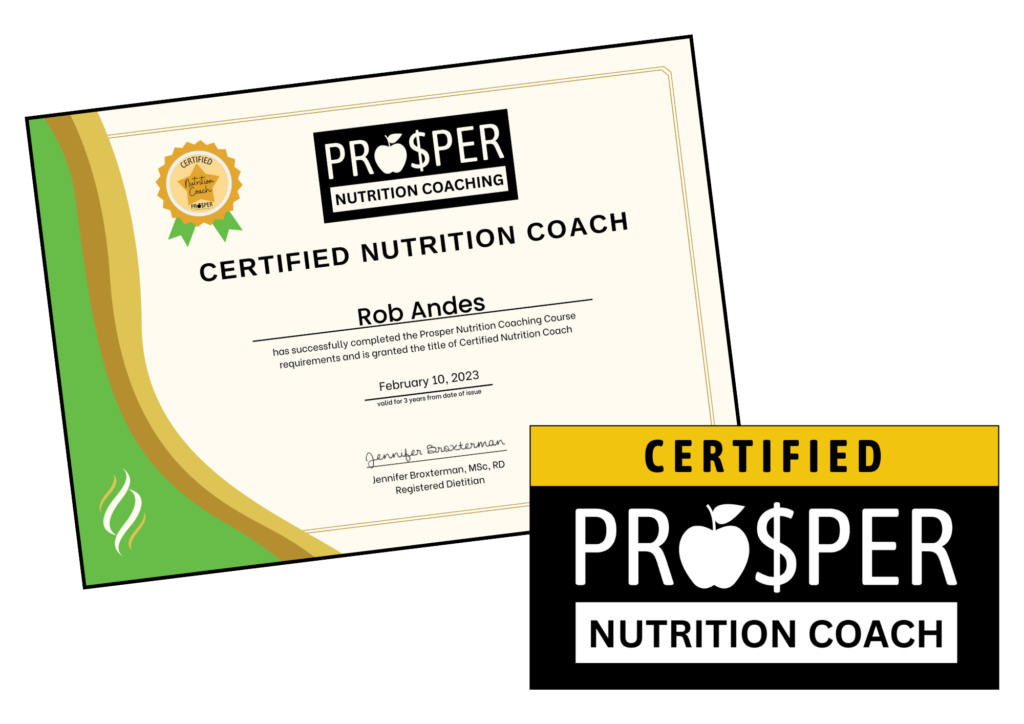

What does habits-based nutrition coaching look like IRL?
Written by Jennifer Broxterman, MSc, RD
Registered Dietitian, Founder of NutritionRx
What does habits-based nutrition coaching look like in real life (IRL)?
As a Registered Dietitian (RD), I often get questions from potential clients asking about the nutrition counselling approach I take.
Will I get a meal plan?
Will you tell me how many calories to eat?
Will I have to cut specific foods from my diet?
Do you want me to track my food online? I’m already logging what I eat in app XYZ.
As I shared in a previous article called “Why I dropped meal plans and macros for happy face nutrition counselling”, my team of Registered Dietitians and I have (generally) moved away from writing individualized meal plans and calculating macros for 99% of our nutrition clients.
Why?
Because we found a much better way to get our clients long lasting-results, with a lot more ENJOYment along the way.
It came down to two key things in my position as not only a nutrition coach, but as a behaviour change facilitator:
• keep it simple
• keep it client-centred
There is a trend in the fitness and nutrition industry to make things way more complicated than necessary.
As I read books on behaviour change and habit formation, learned from experience, and practiced with some of my earliest nutrition clients, I started to notice a few important trends:
- The smarter I tried to sound, the more I overwhelmed my clients
- The “healthier” the nutrition plan I prescribed (theoretically helping my clients reach their goals faster), the higher the failure rate and subsequent disengagement from continuing on
- The more I focused on what the client wanted to work on (thereby abandoning my lesson plan/personal agenda for the session), the better they did
- The easier I made the behaviour change step by helping the client shrink the action they were going to commit to, the more likely the new habit was to stick
- The more I talked about the power of building lasting habits, shaping supportive environments, and working on their mindset, the more MIND-BLOWING their results
- When I realized it’s “about the food, but NOT about the food” and allowed space for talking about the person’s entire life in our nutrition counselling sessions, the more breakthroughs we had
From a theoretical perspective, when we say we coach “habits-based nutrition counselling” with our clients, this is generally what we mean. Sometimes, though, it’s helpful to have a more tangible idea of what this really looks IRL like when you’re sitting in our office or working with one us via video.
Let’s take an example client – we’ll call him Steve.
At our first meeting, Steve and I spent time getting to know each other better.
- I asked questions about his current eating habits, exercise patterns, family life, stressors, and overall goals
- We talked about his past, his present, and where he wanted to go in the future (health-wise)
- We went through several healthy eating concepts and ideas he might want to consider implementing, working through a Healthy Eating Resource Booklet that new clients get to keep that’s filled with ideas, healthy meal and snack examples, and nutritious recipes to try at home
- We then circled back to his overall goals: to be a fit, healthy, and energetic dad and husband while running a super successful company
- Finally, we broke it down into two key areas he wanted to work on, setting up ACTION-based goals that he felt he could reasonably implement between our first and second meeting:
- Habit 1: Eat more vegetables
- Which translated to the action steps of preparing a weekly veggie bucket, and aiming for 1-2 meals/day that included vegetables
- Habit 2: Snack better at work
- Which translated to the action step of making a weekly snack bin on Sundays at 12:30pm, with healthy snacks ready to go for the Monday-Friday busy work week
We then translated those habits into visual symbols so he could quickly and easily monitor and assess his progress week-to-week on a 1-page goal chart located on the back of his Healthy Eating Resource Booklet.
VB = prepped a weekly veggie bucket
✓ = veggies eaten with a meal
SB = snack bucket prepared
That’s it! That’s all he was asked to do for a one month period, putting in the reps, until things started to feel more automatic and easy.
When we met at our next follow-up session, we reviewed what went well, where things got hard, and what was starting to feel more automatic and ingrained into his patterns. Take a look at how things went in real life for Steve:

As you can see from a snapshot of his goal sheet, he nailed the veggies 1-2x/day goal, but had a minor dip in intake when the weekend veggie bucket prep goal fell away, impacting his Monday-Friday nutrition score the following week.
Steve immediately identified this connection, acknowledging the power of guarding and protecting this weekend veggie bucket prep habit, in order to support the bigger habit of eating a large portion of vegetables 1-2x/day, consistently.
Overall, he came back in feeling empowered, motivated, and really proud of himself that he was off to a GREAT START and was already starting to feel a little better, just with that one simple change and narrowed focus, and without taking on too many other adjustments all at once to his eating habits.
The healthy workday snacking goal was also going well, but veggies were off to a fantastic start!
In session 2, Steve wanted to keep the focus on vegetables. He knew things were in a good place, but he wanted to make sure this positive habit stuck around for the long-run. We decided together that it was a good idea to continue with the 1-2x/day vegetable intake goal, along with the weekend veggie bucket prep, and this month, to add a little more challenge, we decided to add in more VARIETY to his vegetable choices.
Out came fun activity #2 – the Vegetable and Fruit Rainbow Game!
This is a really fun healthy eating challenge that turns more whole food eating into a game, by encouraging clients to add as much COLOUR and ABUNDANCE as they can to their vegetable and fruit intake. There are more than 100 options to pick from, and the goal is to see how high you can get your number to go in a 1-2 month time frame, choosing from vegetables and fruits that you enjoy, and also some options that you’ve maybe forgotten about or don’t shop for regularly. It even encourages clients to try some new items they’ve never had before, or to search out new recipes to mix things up (we also cover some of this in our 1-on-1 nutrition counselling session as well).
Here is what Steve’s Rainbow Game looked like when we checked in a session #3.

As you can see, Steve and I had no idea how many calories he ate over these 2 months, or what his precise macro split was. But what you can hopefully see, just like Steve and I both saw, was that his intake of nutrient-dense whole foods was WAY UP, he was eating vegetables on a much more regular basis, his intake of fibre was much higher, he had a lot of variety and colour to his eating habits, and that this was starting to stick!
And the time commitment asked of Steve to track his eating choices and nutrition habits he was working on – mere seconds per day. A check mark ✓ here, a VB there, easy peasy.
This is just one of many examples of habits-based behaviour change coaching we use with our nutrition clients, and is also something I cover in much more detail in the Nutrition Coaching Course I created for health coaches who want to improve their nutrition coaching skills and confidence to work with clients on their own.
As a bonus, these healthy eating resources and goal sheets are included in the course material so you can download them to use with your own nutrition clients, saving you time and effort so you don’t have to reinvent the wheel.
You’ll notice that in our habits-based nutrition counselling approach, we help each client pick immediately tangible ACTION STEPS they can implement right away, based on these 3 most important factors:
• QUALITY:
Am I putting HIGH QUALITY food into my body?
Am I moving along the continuum of healthy eating, even if it’s just a baby step forward?
• QUANTITY:
Did I put the right QUANTITY of food into my body, based on my own personal needs?
• GOALS:
Did this choice move me in the direction of my goals?
We’ve said it before, and we’ll say it again. Sometimes keeping things simple, in fact, radically simple, is best. For the coach, for the client, for everyone’s sanity, and for the sustainability of the results!
Simplicity = sustainability. The harder the program, the harder it is to stick to long-term.
Learning about motivational interviewing and implementing that into our counselling sessions was one BIG thing that not only transformed the results our clients were getting, but also their enjoyment (and OUR enjoyment) of working together long-term. Which is why it’s so important to keep nutrition and behaviour change simple, as well as client-centred, just like you’ll find if you work with us directly or take our Nutrition Coaching Course.
We hope you have enjoyed this example of what habits-based nutrition coaching looks like IRL and we hope you’ll consider doing the same for your own healthy eating habits, or if you’re in a coaching position and you’re working with another human being trying to improve their behaviour in the context of living a real, messy, and constantly changing life!
Wishing you health & happiness,
♡ Jen
Jennifer Broxterman, MSc, RD
Registered Dietitian
NutritionRx: happy, healthy living with our team of Registered Dietitians
Prosper Nutrition Coaching: a world-class nutrition coaching certification
+
+
+
Want to work with a NutritionRx Registered Dietitian?
Learn more here: Nutrition Packages & Rates
+
+
+
Want to become a Certified Nutrition Coach?
Learn more about our habits-based Prosper Nutrition Certification



